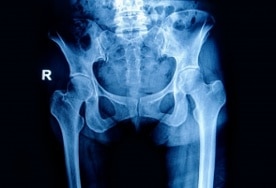Orthopedic Surgery to Replace to the Hip Joint

The hip joint is the largest, most important and complex joint of the body. It is part of the lower pelvic girdle and bears all the weight of the upper half of the body while allowing for locomotion of the body by synchronizing the walking movement of the lower extremities. Classified as a ball and socket joint, the hip joint is comprised of a ball formed by the head of the femur (the long bone present in the thigh region), and a socket formed by the acetabulum cavity (part of the pelvic bone). There are many ligaments and tendons supporting this joint, and cartilage at the articulating surfaces of the ball and the socket provide a smooth surface without any friction.
Hip replacement orthopedic surgery can become necessary for multiple reasons, including:
- Trauma
- Osteoarthitis or rheumatoid arthritis
- Avascular necrosis
- Congenital abnormalities
Normally, the hip joint is very stable and does not give way easily. However, a traumatic accident can cause fracture and dislocation of the hip joint. This extremely painful condition requires immediate surgery.
Osteoarthritis strikes the large joints of the body and the hip joint is most commonly involved. Wear and tear on the joint’s articulating surfaces combine with bony spur growth to greatly restrict movement. Osteoarthritis is usually progressive. It is damaged cartilage.
Patients who suffer from rheumatoid arthritis experience inflammation of the synovial membrane and thickening of the synovial fluid, making it extremely difficult to move about. This condition damages the smooth surface of the joint cartilage through inflamation.
Avascular necrosis of the head of the femur commonly affects the hip joint and causes decreased blood supply to the joint, proving fatal for the joint. Children born with congenital anomalies of the hip often need corrective surgery, as well. This condition is associated with steriods and other medications.
Hip replacement orthopedic surgery is one answer to all these problems. The procedure involves replacing of the head of the femur with a plastic ball, a short stem, and articular cartilage and the socket of the acetabulum to allow the patient to return to a normal lifestyle with pain-free movement. The head and stem of the femur are normally replaced by a metallic component called a prosthesis; the acetabular cartilage is replaced by a plastic spacer; and the socket is replaced by a ceramic or metallic cartilage. Within a few weeks, and with the aid of physiotherapy, patients can return to complete weight-bearing and even running and other sports activities. With hip replacement, the hip joint is essentially “replaced” with metal and plastic.
{{cta(‘bb456f31-3aff-4ca0-a458-b217882fde1b’,’justifyleft’)}}
Image courtesy of Praisaeng / FreeDigitalPhotos.net
Dr. Meredith Warner is a board certified, Fellowship Trained Foot and Ankle, Orthopedic surgeon practicing in Baton Rouge, Louisiana. Dr. Warner is committed to offering her patients an accurate diagnosis along with a comprehensive treatment plan in order to get them back to a pain free life. Dr. Meredith Warner specializes in the treatment of orthopedic issues, providing operative and non-operative treatment plans of orthopedic problems, including musculoskeletal pain such as chronic back, neck and foot pain, reconstructive surgery of the foot and ankle, arthritis, diabetic, hammer toe, bunion, wound care, work injuries, fitness and nutrition and osteoporosis issues.




